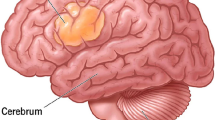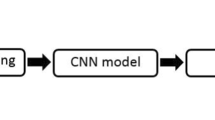Abstract
This study aims to develop and validate a deep learning (DL) model to differentiate glioblastoma from single brain metastasis (BM) using conventional MRI combined with diffusion-weighted imaging (DWI). Preoperative conventional MRI and DWI of 202 patients with solitary brain tumor (104 glioblastoma and 98 BM) were retrospectively obtained between February 2016 and September 2022. The data were divided into training and validation sets in a 7:3 ratio. An additional 32 patients (19 glioblastoma and 13 BM) from a different hospital were considered testing set. Single-MRI-sequence DL models were developed using the 3D residual network-18 architecture in tumoral (T model) and tumoral + peritumoral regions (T&P model). Furthermore, the combination model based on conventional MRI and DWI was developed. The area under the receiver operating characteristic curve (AUC) was used to assess the classification performance. The attention area of the model was visualized as a heatmap by gradient-weighted class activation mapping technique. For the single-MRI-sequence DL model, the T2WI sequence achieved the highest AUC in the validation set with either T models (0.889) or T&P models (0.934). In the combination models of the T&P model, the model of DWI combined with T2WI and contrast-enhanced T1WI showed increased AUC of 0.949 and 0.930 compared with that of single-MRI sequences in the validation set, respectively. And the highest AUC (0.956) was achieved by combined contrast-enhanced T1WI, T2WI, and DWI. In the heatmap, the central region of the tumoral was hotter and received more attention than other areas and was more important for differentiating glioblastoma from BM. A conventional MRI-based DL model could differentiate glioblastoma from solitary BM, and the combination models improved classification performance.




Similar content being viewed by others
Data Availability
The data presented in this study are available on request from the corresponding author. The data are not publicly available due to patient confidentiality.
Abbreviations
- DL:
-
Deep learning
- GBM:
-
Glioblastoma
- BM:
-
Brain metastasis
- MRI:
-
Magnetic resonance imaging
- DWI:
-
Diffusion-weighted imaging
- ResNet:
-
Residual network
- T model:
-
Deep learning model in tumoral regions
- T&P model:
-
Deep learning model in tumoral + peritumoral regions
- AUC:
-
Area under the receiver operating characteristic curve
- T2WI:
-
T2-weighted imaging
- CE-T1WI:
-
Contrast-enhanced T1-weighted imaging
- T2-FLAIR:
-
T2-fluid-attenuated inversion recovery
- cMRI:
-
Conventional MRI
- CNN:
-
Convolutional neural network
- ROI:
-
Region of interest
- Grad-CAM:
-
Gradient-weighted class activation mapping
References
Norden AD, Wen PY, Kesari S: Brain metastases. Curr Opin Neurol 18:654-661, 2005
Gritsch S, Batchelor TT, Gonzalez Castro LN: Diagnostic, therapeutic, and prognostic implications of the 2021 World Health Organization classification of tumors of the central nervous system. Cancer 128:47-58, 2022
Ostrom QT, Wright CH, Barnholtz-Sloan JS: Brain metastases: epidemiology. Handb Clin Neurol 149:27-42, 2018
Suh JH, Kotecha R, Chao ST, Ahluwalia MS, Sahgal A, Chang EL: Current approaches to the management of brain metastases. Nat Rev Clin Oncol 17:279-299, 2020
Weller M, et al.: European Association for Neuro-Oncology (EANO) guideline on the diagnosis and treatment of adult astrocytic and oligodendroglial gliomas. Lancet Oncol 18:e315-e329, 2017
Villano JL, Durbin EB, Normandeau C, Thakkar JP, Moirangthem V, Davis FG: Incidence of brain metastasis at initial presentation of lung cancer. Neuro Oncol 17:122-128, 2015
Kang J, Ullah Z, Gwak J: MRI-Based Brain Tumor Classification Using Ensemble of Deep Features and Machine Learning Classifiers. Sensors (Basel) 21, 2021
Davis ME: Glioblastoma: Overview of Disease and Treatment. Clin J Oncol Nurs 20:S2-8, 2016
Pope WB: Brain metastases: neuroimaging. Handb Clin Neurol 149:89-112, 2018
Villanueva-Meyer JE, Mabray MC, Cha S: Current Clinical Brain Tumor Imaging. Neurosurgery 81:397-415, 2017
Calli C, Kitis O, Yunten N, Yurtseven T, Islekel S, Akalin T: Perfusion and diffusion MR imaging in enhancing malignant cerebral tumors. Eur J Radiol 58:394-403, 2006
Mao J, et al.: Differentiation between high-grade gliomas and solitary brain metastases: a comparison of five diffusion-weighted MRI models. BMC Med Imaging 20:124, 2020
Bauer AH, Erly W, Moser FG, Maya M, Nael K: Differentiation of solitary brain metastasis from glioblastoma multiforme: a predictive multiparametric approach using combined MR diffusion and perfusion. Neuroradiology 57:697-703, 2015
Zaharchuk G, Gong E, Wintermark M, Rubin D, Langlotz CP: Deep Learning in Neuroradiology. AJNR Am J Neuroradiol 39:1776-1784, 2018
Mazurowski MA, Buda M, Saha A, Bashir MR: Deep learning in radiology: An overview of the concepts and a survey of the state of the art with focus on MRI. Journal of Magnetic Resonance Imaging 49:939-954, 2019
Shin I, et al.: Development and Validation of a Deep Learning–Based Model to Distinguish Glioblastoma from Solitary Brain Metastasis Using Conventional MR Images. American Journal of Neuroradiology 42:838-844, 2021
Bae S, et al.: Robust performance of deep learning for distinguishing glioblastoma from single brain metastasis using radiomic features: model development and validation. Scientific Reports 10, 2020
Hua R, et al.: Segmenting Brain Tumor Using Cascaded V-Nets in Multimodal MR Images. Front Comput Neurosci 14:9, 2020
McKinnon C, Nandhabalan M, Murray SA, Plaha P: Glioblastoma: clinical presentation, diagnosis, and management. BMJ:n1560, 2021
Rosenfelder N, Brada M: Integrated treatment of brain metastases. Curr Opin Oncol 31:501-507, 2019
Su CQ, et al.: A radiomics-based model to differentiate glioblastoma from solitary brain metastases. Clin Radiol 76:629.e611-629.e618, 2021
Qian Z, et al.: Differentiation of glioblastoma from solitary brain metastases using radiomic machine-learning classifiers. Cancer Lett 451:128-135, 2019
Csutak C, et al.: Differentiating High-Grade Gliomas from Brain Metastases at Magnetic Resonance: The Role of Texture Analysis of the Peritumoral Zone. Brain Sci 10, 2020
Heynold E, et al.: Physiological MRI Biomarkers in the Differentiation Between Glioblastomas and Solitary Brain Metastases. Molecular Imaging and Biology 23:787-795, 2021
Yan J-L, Li C, Anouk, Boonzaier NR, Matys T, Price SJ: A Neural Network Approach to Identify the Peritumoral Invasive Areas in Glioblastoma Patients by Using MR Radiomics. Scientific Reports 10, 2020
Samani ZR, Parker D, Wolf R, Hodges W, Brem S, Verma R: Distinct tumor signatures using deep learning-based characterization of the peritumoral microenvironment in glioblastomas and brain metastases. Scientific Reports 11, 2021
D'Alessio A, Proietti G, Sica G, Scicchitano BM: Pathological and Molecular Features of Glioblastoma and Its Peritumoral Tissue. Cancers (Basel) 11, 2019
Lemée JM, Clavreul A, Menei P: Intratumoral heterogeneity in glioblastoma: don't forget the peritumoral brain zone. Neuro Oncol 17:1322-1332, 2015
Swinburne NC, et al.: Machine learning for semi-automated classification of glioblastoma, brain metastasis and central nervous system lymphoma using magnetic resonance advanced imaging. Ann Transl Med 7:232, 2019
Togao O, et al.: Differentiation of high-grade and low-grade diffuse gliomas by intravoxel incoherent motion MR imaging. Neuro Oncol 18:132-141, 2016
Zhou X, Su Y, Huang W, Lin X, Xing Z, Cao D: Differentiation between supratentorial pilocytic astrocytoma and extraventricular ependymoma using multiparametric MRI. Acta Radiol 63:1661-1668, 2022
Kono K, et al.: The role of diffusion-weighted imaging in patients with brain tumors. AJNR Am J Neuroradiol 22:1081-1088, 2001
Martín-Noguerol T, Mohan S, Santos-Armentia E, Cabrera-Zubizarreta A, Luna A: Advanced MRI assessment of non-enhancing peritumoral signal abnormality in brain lesions. Eur J Radiol 143:109900, 2021
Ebrahimi A, Luo S: Convolutional neural networks for Alzheimer’s disease detection on MRI images. J Med Imaging (Bellingham) 8:024503, 2021
Yang C, Rangarajan A, Ranka S: Visual Explanations From Deep 3D Convolutional Neural Networks for Alzheimer’s Disease Classification. AMIA Annu Symp Proc 2018:1571-1580, 2018
Selvaraju RR, Cogswell M, Das A, Vedantam R, Parikh D, Batra D: Grad-CAM: Visual Explanations from Deep Networks via Gradient-Based Localization. International Journal of Computer Vision 128:336-359, 2019
Barajas RF, Jr., et al.: Regional variation in histopathologic features of tumor specimens from treatment-naive glioblastoma correlates with anatomic and physiologic MR Imaging. Neuro Oncol 14:942-954, 2012
Lemercier P, Paz Maya S, Patrie JT, Flors L, Leiva-Salinas C: Gradient of apparent diffusion coefficient values in peritumoral edema helps in differentiation of glioblastoma from solitary metastatic lesions. AJR Am J Roentgenol 203:163-169, 2014
Würtemberger U, et al.: Diffusion Microstructure Imaging to Analyze Perilesional T2 Signal Changes in Brain Metastases and Glioblastomas. Cancers (Basel) 14, 2022
Author information
Authors and Affiliations
Contributions
Qingqing Yan and Qingshi Zeng contributed to the study’s conception and design. Material preparation and data collection were performed by Wenjing Jia, Yuting Li, Huan Chang, Fuyan Li, Yi Cui, Xiao Wang, and Yong Wang, and data analysis was performed by Feng Shi, Yuwei Xia, Qing Zhou, and Qingqing Yan. The first draft of the manuscript was written by Qingqing Yan and Qingshi Zeng, and all authors commented on previous versions of the manuscript. All authors read and approved the final manuscript.
Corresponding author
Ethics declarations
Ethics Approval
This retrospective study was approved by the local Institutional Review Board, and a waiver of informed consent was made.
Consent for Publication
Not applicable.
Conflict of Interest
The authors declare no competing interests.
Additional information
Publisher's Note
Springer Nature remains neutral with regard to jurisdictional claims in published maps and institutional affiliations.
Supplementary Information
Below is the link to the electronic supplementary material.
Rights and permissions
Springer Nature or its licensor (e.g. a society or other partner) holds exclusive rights to this article under a publishing agreement with the author(s) or other rightsholder(s); author self-archiving of the accepted manuscript version of this article is solely governed by the terms of such publishing agreement and applicable law.
About this article
Cite this article
Yan, Q., Li, F., Cui, Y. et al. Discrimination Between Glioblastoma and Solitary Brain Metastasis Using Conventional MRI and Diffusion-Weighted Imaging Based on a Deep Learning Algorithm. J Digit Imaging 36, 1480–1488 (2023). https://doi.org/10.1007/s10278-023-00838-5
Received:
Revised:
Accepted:
Published:
Issue Date:
DOI: https://doi.org/10.1007/s10278-023-00838-5




